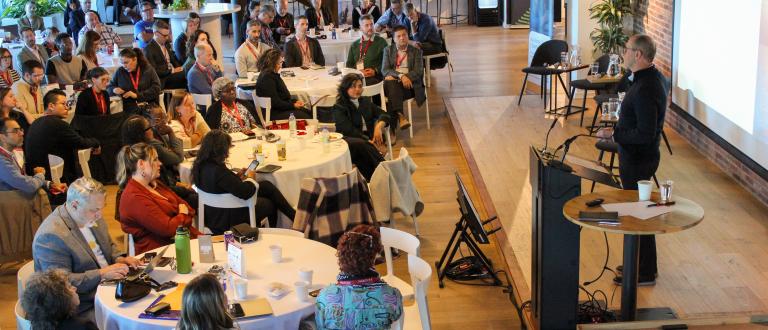Stop for a minute and think about a charity or company that you admire. Now think about any person who works there - how would you describe them?
Part of the reason why most employees, supporters or customers admire charities and companies is because their values resonate with them. Taking the time to invest in your organization’s culture is an HR practice that can lead to better team cohesion and greater output from your employees.
During my summer at Imagine Canada, I worked on various Human Resources projects, including a development of a 360 assessment focused on staff values and culture. Before I go into specifics, there are two clarifications to keep in mind:
- 360 Performance Reviews. These are usually focused on employee’s performance only. Assessment questions relate to how much work you have done and how well you did. These can be answered from the perspective of supervisor, peers, direct reports, customers, etc.
- 360 Staff Values Reviews. Are an assessment of how employees contribute to the culture of the workplace. Were you an innovative thinker? Did you put interests of the organization before your own? Did you listen to your peers? Overall, questions with more biases and ambiguity and a lot less quantitative aspect to them.
The main challenge with my project at Imagine Canada was the lack of existing information or examples to learn from because only a few organizations have implemented a similar assessment system. Thus, the process of building it included a lot of ambiguity and tough choices very specific to Imagine Canada’s culture. However, I will break down our learnings with the hope to help other nonprofit organizations develop a similar system.
This is the first part in a two-part series, looking at how to develop staff values that accurately describe your organization. Part 2 is a step-by-step guide in implementing your staff values, which you can jump to here.
Understand the culture of your organization
I proceeded to learn more about Imagine Canada’s culture and staff values. In developing your own assessments, there are two starting points to consider:
1. You don’t have established Staff Values
Start by developing a survey or interview staff to ask them to describe the culture. Here you can provide a few examples of companies with great work culture, as well as a word bank or list of questions to help your staff. It might help to raise questions that staff should ask themselves to stay on track with what you are looking for. (i.e. how would you describe a good feedback session with your supervisor? How would you describe the organization’s relationship with its stakeholders? How would you describe your daily interactions with coworkers outside of/during meetings?)
2. You have established Staff Values
If your organization has already articulated their Staff Values, you could proceed to break down each value further into a set of behaviour statements that would later be used to evaluate staff’s contribution to the workplace culture:
-
Top-Down Approach. What kinds of behaviours related to the staff values does the leadership want to see in their employees? This might be easier, but there is also a big chance of a disconnect with the staff if their opinion is not incorporated.
-
Bottom-Up Approach. This option is more time-consuming and requires leadership to actually ask staff about their idea of behaviours associated with those values. Set up one-on-one interviews and ask them how they see a certain value being lived by their coworkers. Be inquisitive and make sure you get the how’s and why’s during those interviews. Do not stop at them giving you a general example of good/bad behaviour—these have to be related to the specific value you are discussing. If you see that some of them overlap, then ask what the difference is in the eye of the person you are discussing it with. The ultimate goal is to understand the underlying behaviours for each value.
Imagine Canada's Staff Values:
Collaborative: We believe different perspectives create great things.
Integrity: We are principled professionals who embrace trust and honesty.
Levity: We take our work seriously and fuel it with moments of joy and good humour.
Creativity: We create using our resourcefulness, ingenuity and imagination.
Candour: We communicate with a truthful and sincere frankness.
Remarkable: We produce work that turns heads.
Create a diverse HR committee
Once you have the results of your values interviews, put together an internal team to continue developing the assessment (that’s what we did). Do you already have an HR committee or department? Great! If not, then you should definitely have one. After all, HR is the glue that holds your organization together.
This committee is reflective of the organization, so make sure it is diverse and open to different ideas. A lot of the issues you will be discussing are complex and unique to the organization. Complexity can definitely get in the way of accomplishment, but consider your first year a trial run: do the best you can and fix the process based on the feedback you receive.
Define your Staff Values
First item on our agenda was breaking down each value into behaviour statements. Look over the values and the staff’s outlook on them, then, based on the trends you see, come up with a set of behaviours for each one. Remember that people or departments might have different definitions for each value (Creativity in accounting? What does that mean?). Try to make behaviours all-inclusive. Also, be specific about what you’re evaluating for each behaviour. For example, the definition: “They are open to, listen to and integrate others’ opinions,” could confuse someone who thinks that their peer listen but never integrates others’ opinions.
This is an example of a common value and how it was broken down for Imagine Canada:
At the end, you should have something similar to this for each value/aspect of your definition if workplace culture.
By working through every step of the process you will help your organization to strengthen a workplace culture that employees can contribute to and see themselves in. Investing the time to think about your organization’s staff values can go a long way in fostering a productive and supportive work environment.
Read Part 2 of this blog to learn about how to implement a 360 Staff Values assessment.



